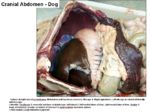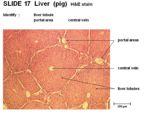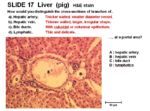Liver - Anatomy & Physiology
Introduction
The liver (hepar) is an extremely important organ in the body of mammals and vertebrates which provides functions essential for life. It is the largest internal organ and has numerous functions including production of bile and protein, fat and carbohydrate metabolism. During foetal development, the liver has an important haemopoetic function, producing red and white blood cells from tissue between the hepatic cells and vessel walls.
The size of the liver varies due to its role in metabolism. In carnivores the liver weighs about 3-5% of body weight, in omnivores 2-3% and in herbivores 1.5%. the liver is much heavier in young animals rather than older animals as it atropies with age.
The liver is derived from an outpocketing of endoderm epithelium on the ventral duodenum from the caudal part of the foregut. The connetion to the gut narrows to become the bile duct. The parenchymal tissue of the liver is formed from proliferating epithelial cords or strands which intergrate with the blood sinuses of the umbilical and vitelline veins. The mesoderm of the septum transversum forms the venous sinosoids and connective tissue of the liver.
Structure
- Cranial part of the abdomen
- Immediately caudal to the diaphragm
- Cranial to the stomach and intestines
- Generally the bulk of the liver on the right of the midline
- Divided into lobes by fissures
- Cranially the liver is convex, called the diaphragmatic surface
- Caudally the liver is concave, called the visceral surface
- Caudate lobe has a renal impression from the right kidney
- Gastric impression occupies the whole of the left half of the visceral face
- Duodenal impression at the junction of the right and quadrate lobes continuing onto the right lateral and caudate lobes
- Passgaes or notches on the median plane allow the caudal vena cava and oesophagus to pass by
- The gallbladder is located between the right medial and quadrate lobes
- Reticular fibres (collagen type III, proteoglycans and glycoproteins) support the hepatocytes and walls of the sinusoids
- Interlobular spaces support bile ducts and blood vessels
- Lesser omentum (often fat filled) on the visceral surface between the left lateral lobe, heptic porta and lesser curvature of the stomach
- Oesophageal notch where oesophagus passes over the liver
Divisions of the Liver
- Lobes
- Lobules
- Hepatocytes and sinusoids
Lobes of the Liver
- Left lateral
- Left medial
- Right lateral
- Right medial
- Quadrate
- Caudate
- Papillary
Ligaments
- Coronary ligament
- Between the liver and disphragm on the diaphragmatic surface of the liver
- Irregular fold of peritoneum
- Surounds the triangular base of the diaphragmayic surface
- Continuous with outer most layer of the caudal vena cava
- Falciform ligament
- Ventral to the coronary ligament
- Fat filled embryological remnant of the fetal blood vessels from the placenta
- Causes problems for surgical entry into the abdomen
- Located cranial to the umbilicus
- Triangular ligament
- Right and left sides of the coronary ligament
Function
Vasculature
- Dual blood supply
- 70-80% hepatic portal vein (nutrient rich)
- 20-30% hepatic artery (oxygen rich)
- Blood flows from the portal areas into the central vein
- Central vein lined by simple squamous epithelium
- the ile duct, blood vessels and nerves enter and leave the liver at the hepatic porta
Innervation
Lymphatics
Histology
- Connective tissue capsule around each lobule
- Thin mesothelium covers connective tissue layer
- The larger liver cells are called lobules
- Each lobule contains an opening for the central vein and contains portal areas
- Lobules composed of liver cords called hepatocytes
- Sinusoids present between hepatocytes containing red blood cells
- Portal area present in lobules
- Hepatic artery- thick walls, small diameter
- Hepatic vein- thin walls, large and irregular shape
- Bile ducts- cuboidal or columnar epithelium
- Lymphatics- small and delicate
- Hepatocytes are the smaller liver cells in the lobules
- Contain glycogen granules
- Pink stain as are eosinophilic
- Spherical nucleus
- Forms cords called branching plates (lamellae)
- Upper and lower margins are tight junctions
- 3 functioning surfaces
- Adjacent to sinusoid contains microvilli
- Between adjacent cells are smooth
- Adjacent cells have short microvilli, membranes diverge, explanded intracellular spaces and bile canaliculi
- Kupfer macrophages present near the lining of the sinusoids
Species Differences
Canine & Feline
- Both left and right lobes subdivided
Equine
- Contained entirely within the rib cage
- To the right of the midline
- Less lobated
- No gall bladder
- Left lobe subdivided
- No papillary lobe
Porcine
- Deep interlobular fissures
- Large amount of interlobular connective tissue
- Mottled appearance
- Deep interlobular fissure divides the lived into 4 lobes- the left, right, medial and lateral
- Small caudate lobe (which does not contact the kidney so no renal impression)
- Mostly on the right of the midline
- No papillary lobe
Ruminants
- Entirely displaced to right of midline
- Fused lobes
Small Ruminants
- Sheep have a deeper umbilical fissure than cows
- Sheep have a smaller caudate lobe than cows
- Sheep have two papillary processes
Avian
- See avian liver



